| THE INDUSTRIAL RAILWAY RECORD |
© AUGUST 1969 |
INDUSTRIAL LOCOMOTIVES OVERSEAS
10 - NEW ZEALAND
BRIAN WHEBELL
Overseas enthusiasts could be excused for thinking that New Zealand, with a population of less than three million, little or no heavy industry, and an economy based on agriculture has very little scope for industrial railways and locomotives. In this age of motor trucks and conveyor belts this is becoming increasingly true, but it has not always been so.
Two of the largest users of private locomotives are industries that are unknown in the British Isles-frozen meat and timber logging on a large scale. With frozen meat making up a large percentage of the country's exports, the movement of cattle and sheep from farms all over the country to the killing works (abattoirs), the transport of the finished product to the ship's side, provides the New Zealand Government Railways (NZGR) with a large proportion of their traffic. But inside the works themselves it also calls for a great deal of shunting - sorting the sheep from the goats as it were - and nearly all the freezing works have locomotives of their own to carry this out.
One peculiarity of industrial locomotives in New Zealand is the very high proportion of ex−NZGR engines used. This stems mainly from a blunder made by the originators of the Government system in the 1870's. With the idea of making the available money stretch as far as possible, they constructed only the lightest of track and planned to work lines entirely with small tank engines. It took only a few years to prove this theory wrong. The great increase in traffic caused the hurried ordering of larger and more powerful tender engines and left a legacy of one of the smallest main line loading gauges in the world, as well as a large number of small tank engines with little work to do and a lot of life left in them.
Although too small for main-line work, they proved to be just what the freezing works, sawmills and coal mines wanted, and they found a ready sale all over the country which continued steadily right up until the 1950's. Being standard classes, spares were easy to obtain and could be interchanged between engines. In later years the NZGR retired those retained for their own use, and these were always available for spares if no buyer could be found for the complete engine. The net result was that many of the industrial lines were veritable operating museums of the very earliest NZGR classes.
In the early part of this century, sawmillers were well to the fore in the purchases of ex−Government engines, which were put to work on logging railways, or "bush tramways" as they are always called in New Zealand. These tramways fell into two categories, firstly the line leading from the sawmill into the bush area where the trees were being felled, and then a more permanent line to carry sawn timber from the mill to the nearest NZGR railhead. The first line was gradually extended as the cutting area moved away from the mill and many temporary branches were laid to reach areas too far away from the main line to allow logs to be hauled to it by winches. Much of this track was very roughly laid and earthworks kept to a bare minimum, resulting in steep grades and sharp curves. Generally the line would follow a river valley wherever possible, but often spurs and bluffs were encountered that made deviations around or over necessary. Sometimes this entailed the construction of spirals or zig-zags to gain height or lengthy wooden trestle bridges set in the riverbed itself. Very seldom was tunnelling resorted to.
On the smaller tramways, with relatively easy grades and light loads, the small tank engines were able to manage successfully, but some of the larger mills operating in rugged country soon found the need for more powerful locomotives. As speed was unimportant, geared locomotives were resorted to. Some were imported from the U.S.A. where they had been designed for just such work, while others were built in New Zealand. These latter ranged from the products of A. & G. Price & Co Ltd of Thames (most of which were little more than copies of the basic American designs) to the very primitive contraptions cooked up in the local foundries located in the bush areas. These usually consisted of second-hand boilers, parts from steam winches, and any other odds and ends that suited the purpose.
Of the three main types of American geared engines, only the Heisler and Climax were used in New Zealand. The Shay, although the most popular of the three in the States and used extensively in Australia, was never seen on a New Zealand tramway. (Conversely, the Heisler was never used in Australia!)
Of the New Zealand built designs, one in particular was unique. Known as the "16 wheeler" (for want of a better description), it consisted of a flat frame about 32ft long, mounted on four 4−wheeled bogies by means of span bolsters. A locomotive type boiler was set upon the frame at one end and a large water tank, with a wood rack on top, at the other. In between there was a long cab containing, in the centre, a two cylinder vertical steam engine of the marine type. This drove, through a two−speed gearbox and a large spur gearwheel, a line shaft mounted below the frame. This in turn drove each axle on all four bogies by means of bevel gears, universal and sliding joints being fitted between each bogie to obtain flexibility. These fantastic machines were very powerful and had excellent adhesion on the typically rough bush trackwork, but were extremely slow. To change gear it was necessary to stop and then move the gear lever sideways. This slid a pair of spur wheels along the engine drive shaft, disengaging from one gear train, passing through a neutral position and then engaging the other ratio train. However many of the old bush drivers prided themselves on being able to change gear on the move, although on occasions pride led to some nasty falls when trying to change down before descending a steep grade and missing the gear! The load soon gathered speed without the resistance of the engine, and without its help the brakes were of little use. At other times when in a hurry home in a long easy down grade, they would put the engine in "neutral" and let her coast along at higher speeds than possible with the drive engaged: this was usually referred to as the "Maori Overdrive”!!
Two firms supplied "16 wheelers", A & G Price in the North Island and Johnston Bros of Invercargill in the South. Price's also built a number of similar but smaller engines running on two 4−wheeled bogies, similar to the American "A" type Climax. Later they copied the Climax "B" class which they modified by mounting on Heisler bogies. Another of their products was a four cylinder Meyer type 0−4−4−0 side tank with geared drive. Two outside cylinders mounted on each bogie drove a crank shaft between the axles, to which the power was transmitted by spur gears. Their final steam locomotive was built in 1944 and was based on the American Heisler design, the main difference being a valve gear of their own design, wing tanks extending out beyond the smokebox and a parallel boiler. This latter was its chief weakness, causing priming when climbing steep grades, its American counterpart being fitted with a very sharply tapered boiler especially to prevent this.
Johnston Bros' other "standard" design was a small 0−4−0 with geared drive, usually fitted with a tender although one or two side tank versions were built. These engines had inside cylinders, which drove through reduction gearing on to a jackshaft, which was in turn coupled to the wheels by side rods. The Auckland firm of Gibbon & Harris built some small 0−4−0 well tanks with inside cylinders that were triple reduction geared to the leading axle.
British locomotive builders, however, were not entirely ignored and
Andrew Barclay in particular supplied several engines to New Zealand. In 1907
they supplied a duplex locomotive (Barclay 1130) to the Brownlee Timber Company
of Havelock. This consisted of two normal 0−4−0 side tanks permanently coupled
cab to cab and operated by a single crew, an idea unsuccessfully tried several
times before in other countries and which proved just as unsuccessful in this
instance. By 1916 they had been separated into two engines each of which went
its own way. One, converted to a diesel, is still at work in the North Island,
while the remains of the other are rusting away at the Ruru mill in the South.
In 1913 Barclay also supplied JOAN (works number 1299), a Meyer type 0−4−4−0
articulated side tank, to a land development company operating in the Rimutaka
ranges. Their scheme did not last very long and after a brief spell shunting a
freezing works and later a gravel quarry, she ended her days working on the
Kaniere-Hokitika Sawmilling Company's bush tramway where she proved quite
satisfactory. (continued)
![]()
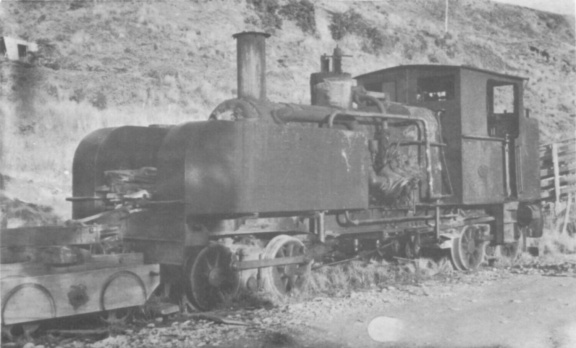
The last steam locomotive built by A. & G. Price & Co Ltd of Thames, New Zealand, in 1944 out of use on 11th June 1960 after closure of the bush tramway of W. T. Ogilvie & Son Ltd at Gladstone. It was the only one of this type built (Price's class V) and was a modification of the American Heisler. In front of the loco is one of the bogies on which logs were carried. When the outside brake boards which bore upon the side of the wheels became too deeply grooved on one side (as in this example) they were turned round to use the other face. The brake action was automatic - when the engine brake was applied, the slack ran in and the buffers operated the brakes by a system of levers and bellcranks. (B. D. Whebell)
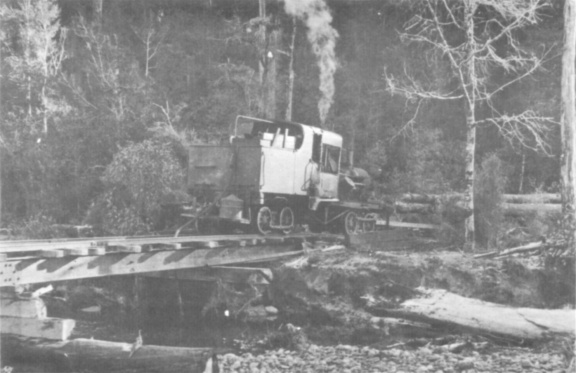
Heisler 1494 (built 1924) at the New Forest Sawmilling Co Ltd, Kangarve Creek, about 1959. Some tramways had proper water tanks but many made use of "water lifters" (as used on traction engines) to get water from any available creek or river as shown here. Note the typical bush trackwork and bridge. When starting away the fireman would sand the track from the back platform where a 44gall drum containing sand can be seen. (B. D. Whebell)
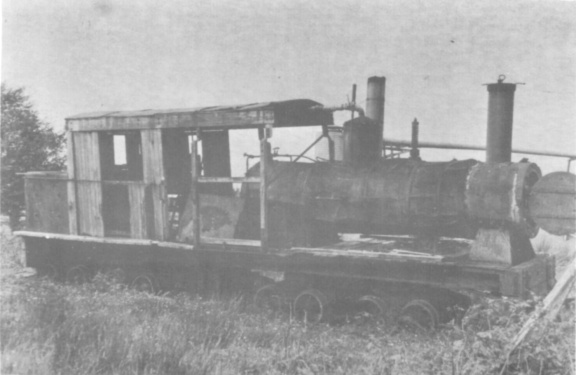
The last survivor of the unusual Johnston "16 wheelers" in a rather derelict state on 20th November 1955 at the Kaniere-Hokitika Saw milling Company, Kaniere. The vertical cylindered engine can just be seen inside the cab, with large gearwheel and part of the driveshaft under the frames between the centre bogies. (B. D. Whebell)
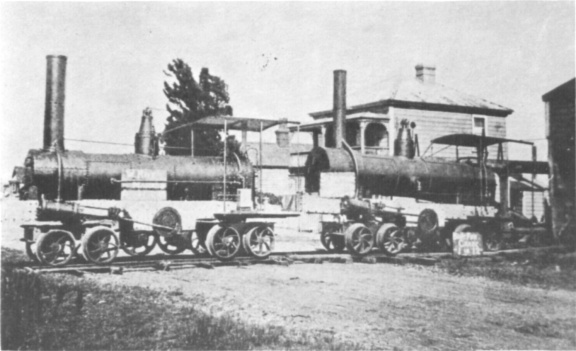
A pair of "standard" locomotives built in 1911 by G & D Davidson of Hokitika, the one on the left being for W. Roe, Manaru, Auckland. The other, for Stratford & Blair L td (possibly at the Kaimata mill), is marked "Built for grade - 1 in 12". Both locos had boilers second-hand from the NZGR. The drive was reduction geared from the main shaft through large gear wheels (visible underneath) on to two secondary shafts. From here it was by chain to the inner axle of each bogie and this in turn was coupled to the outer axle by another chain. The purchasers had to supply their own tenders! Some had bogie tenders with the leading bogie also driven through further chains. (collection B. D. Whebell)
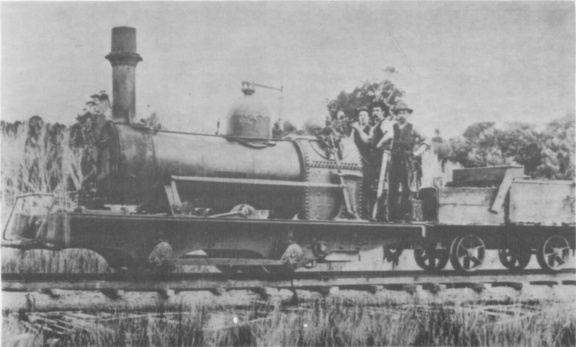
A most unusual locomotive at McCallum & Co, Longbush, Southland, which is said to have been built by Thos. Robinson, Rochdale, England! Note the main steam pipes from the front of the smokebox. (collection J. McNamara)
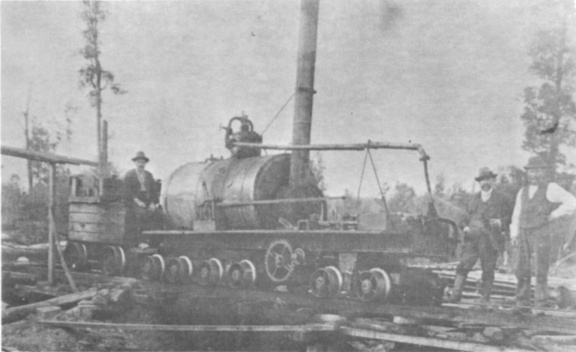
A faded print of a bizarre creation of the Dispatch Foundry, Greymouth (built 1905, works number 45) at the Patara mill of Stratford & Blair Ltd. It is rumoured that the boiler was salvaged from a ship wrecked on a local beach! The locomotive hauled itself along by means of a cable lying in the centre of the track which was wound round a drum on the loco a number of times and then released to drop between the rails again. The pair of cylinders at the front of the locomotive drove this drum via the gear wheels which can be seen at the side. The cable, which was anchored to the ground at both ends, may just be seen on the right of the loco where the gent on the extreme left has his foot on it. Locomotives of this style in the USA were known as "Gripwheels" or "Walking Dudleys". It would not be correct to call this curiosity a "16 wheeler", for this term was used to indicate a locomotive where all 16 wheels were driven from the engine in the cab via the central drive shaft, bevel gears, etc; Although this particular locomotive ran on three 4−wheeled bogies, it was only carried by them and there was no drive to the axles. (B. D. Whebell)
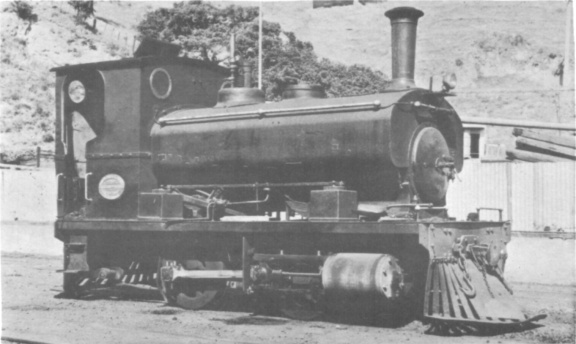
Barclay 1181 of 1909 in February 1960 at the Ngauranga Meat Works of the Wellington Meat Export Company. (B. D. Whebell)
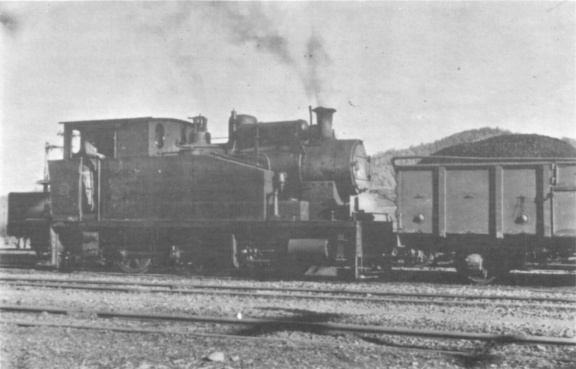
Originally supplied to a meat freezing works, Barclay 1753 of 1921 worked for a long period on railway construction work for the Public Works Department as PWD 551. It was later offered to the NZGR but declined. It eventually passed to the State Coal Mines Department and worked at Burkes Creek Colliery, Reef ton, until it closed in 1962; then it was scrapped. Photo taken at Burkes Creek on 27th June 1960. (B. D. Whebell)
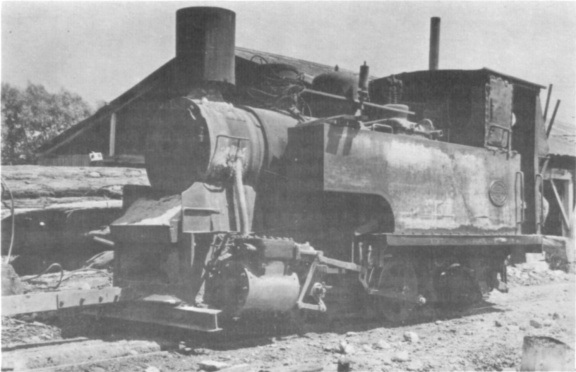
Barclay 0−4−2 side tank 1894 of 1926 at the Lake Brunner Sawmilling Company at Ruru on 14th January 1961. The rope coiled round the sand dome might come in handy for re−railing wagons in the bush or for hauling logs into position. This loco was withdrawn in 1961. (B. D. Whebell)
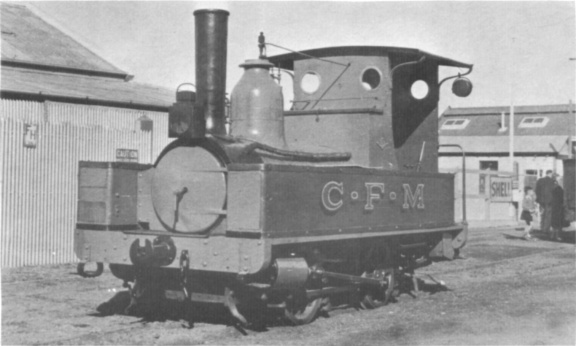
Dubs 651 of 1873, ex−NZR class "A" No. 64, normally worked at the Fairfield Freezing Works, Ashburton, of the Canterbury Frozen Meat Company, but when this photo was taken on 12th September 1959 it was on display at the South Canterbury Centennial Exhibition at Timaru. This loco was in service until 1961 and has since been preserved. (B. D. Whebell)
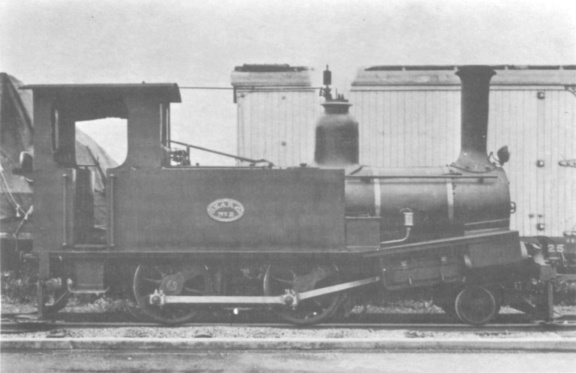
Although the design was already obsolete and of no use to the NZR, the Government of the day ordered class "D" locos to be built locally on account of political pressure against importing locomotives. The one illustrated was built by Scott Bros of Christchurch in 1887 (works number 31) and was NZGR No. 137 until sold to the Gear Meat Co Ltd at Petone. Here it acquired a nameplate, GEAR No.2. The slidebars are boxed in because of sand dunes beside the line. Photo taken about 1955. This loco remained in service until 1964. (B. D. Whebell)
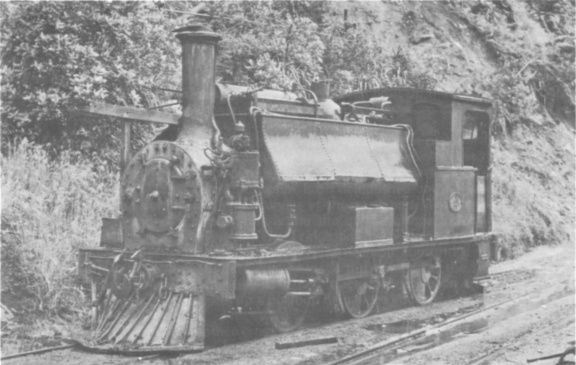
Avonside 0−6−0 saddle tank 1141 of 1876, still carrying its NZGR numberplate 2, at the Charming Creek Coal Company, Ngakauwau, about 1958. This was the last NZGR "F" class loco to be sold (in 1954) to a private owner. (B. D. Whebell)
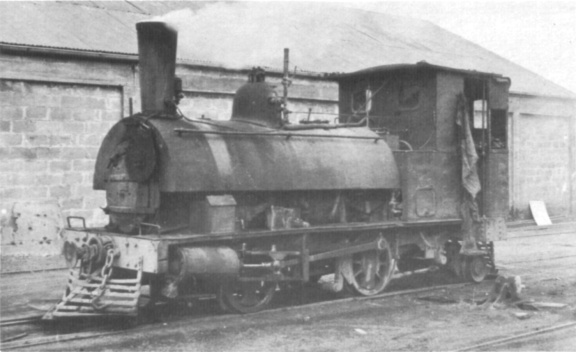
Dubs 885 of 1875 (formerly PWD 512) of the State Coal Mines Dept at Taupiri Colliery, Rotowaro, in February 1960. This type was originally built as an 0−4−0 saddle tank, but all examples had a trailing axle added very early on account of a tendency to "wag their tails". This locomotive is standard with the NZGR "C" class although it has never been owned by the NZGR. (B. D. Whebell)
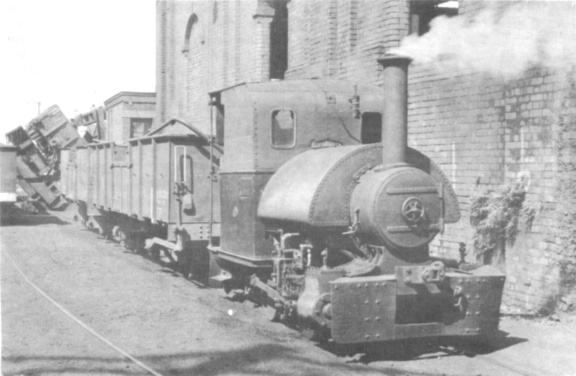
Bagnall 1857 of 1909 shunts wagons to the tippler at Christchurch Gasworks in March 1960. Owned by the Christchurch Gas Coal & Coke Co. Ltd. (B. D. Whebell)
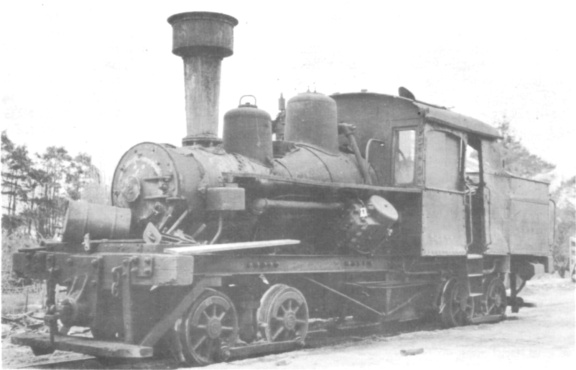
Heisler 1450 of 1922 - a logging loco in typical condition with oil drum, timber jacks and anything else likely to be useful carried on the front. Air leaks round the smokebox door have been filled with mud/asbestos. Photographed on 23rd September 1956 at the Gladstone mill of W. T. Ogilvie & Son Ltd. Later sold to the New Forest Sawmilling Company at Ngahere where it last worked on 23rd March 1968. Transported to the Fairymead Museum on 5th October 1968. (B. D. Whebell)
One of the largest bush systems was that operated by the Taupo Totara Timber Company out of Putaruru in the North Island. Their main line to the mill at Mokai was nearly fifty miles long and for part of the way ran on the formation of the old Thames Valley & Rotorua Railway. Over this they carried passengers and supplies to isolated settlements as well as the sawn timber from the mill. The trains were worked by Heisler geared engines or a 2−4−4−2 Mallet tender engine supplied by the American Locomotive Company in 1913. This was the only one of its kind in the country and one of the smallest tender Mallets ever built in America, weighing only 31% tons in working order. From the mill at Mokai, bush lines radiated for many miles in all directions, some of the earlier ones being laid with wooden rails. These were worked by smaller geared engines as well as a pair of ex−NZG R "A" class 0−4−0 side tanks.
Before concluding this brief survey one final line should be mentioned, that of the Ohai Railway Board in Southland. This was built to connect a number of coal mines in the Nightcaps-Ohai area with the NZGR railhead at Wairio. Unable to finance it themselves, the mine owners took advantage of a little-used legal clause to set up a Local Board to raise the money to build and operate the line. Built to main line standards, it has some steep grades and handles a heavy traffic, which calls for the most powerful industrial locomotives in the country, mostly ex−NZGR. I n steam days these culminated in a pair of "X" class 4−8−2's, the first class of engine with this wheel arrangement in the world. Originally turned out by the Addington Works from 1908 onwards as four cylinder de Glehn compounds, Nos.442 and 446 were converted to four cylinder simples just prior to their sale to the Board in 1944 and 1946 respectively. They remained the last examples of the class, outlasting their NZGR sisters by many years. The Board also obtained a "Wab" class 4−6−4 side tank from the NZGR in 1955, trading in their smal1102hp Drewry diesel shunter in part payment. The only steam locomotive purchased new by the Board was BENONI, a 4−6−2 side tank built in 1927 by Hawthorn Leslie (works number 3663), the only tank engine of that wheel arrangement to work in New Zealand. When the large 4−8−2's arrived she became surplus and was sold to the State Mines Department (equivalent of the British National Coal Board) and transferred to the North Island where she is still hard at work at Rotowaro. The 4−8−2's in their turn were displaced by a pair of Drewry diesel mechanicals by 1957, although one was held as standby until November 1965, when after one final run with an enthusiast's special, she was presented to the railway museum being formed at Ferrymead near Christchurch. Now the two Drewry's are in turn to be replaced by a pair of diesel hydraulics of greater horsepower, recently ordered from Mitsubishi in Japan. True to tradition they are to be of a standard NZGR class as the NZGR also ordered a number of identical locomotives from the same builder at the same time; but on this occasion the Ohai Railway Board will be getting new locomotives and not second-hand ones
|
Appendix 1 |
Examples of early NZGR classes sold to industrial users (all 3ft 6in gauge): |
||||
|
|
Class "A" |
Class "C" |
Class "D" |
Class "F" |
Class "G" |
| Type | 0-4-0T | 0-4-2ST | 2-4-0T | 0-6-0ST | 4-4-0ST |
| Date First Built | 1873 | 1873 | 1874 | 1872 | 1873 |
| Outside Cylinders | 8in x 15in | 9˝in x 18in | 9˝in x 18in | 10˝ x 18in | 10˝in x 18in |
| Coupled Wheel Diam. | 2ft 6in | 2ft 6in | 3ft 0in | 3ft 0in | 3ft 0in |
| Weight in Working Order (tons and cwts) | 11-5 | 15-15 | 17-00 | 20-4 | 20-10 |
|
Class "A" |
Number built, 14. (Dubs 1873, 12: Yorkshire Engine Co 1875,2) |
|
Class "C" |
Number built, 16, (Neilson 1873, 10: Dubs 1875,6.) |
|
Class "D" |
Number built, 33. (Neilson 1874-1880, 17: Dubs 1878, 5 : Scott 1887-1890 11.) |
|
Class "F" |
Number built, 88. (Neilson 1872-1888, 12: Black Hawthorn 1873, 1: R. Stephenson
1873-1886, 12: Yorkshire Engine Co 1874, 11: Vulcan Foundry 1875-1887,5:
Avonside 1875-1876,26: Dubs 1878-1884,21.) |
|
Class "G" |
Number built, 4.
(Black Hawthorn 1873.) "Passenger" version of "F" class. |
| Notes: | (1) |
NZGR classes "B" & "E" were double Fairlies and not suitable for industrial use. |
| (2) |
In addition to the 33 "D" class built for the NZGR, Scott Bros (of Christchurch N.Z.) built one in 1910 to the order of the Napier Harbour Board. Also Neilson supplied an "improved D" in 1884 to the Kaitangata Railway & Coal Company (works number 3282). |
Appendix 2
Examples of Industrial Locomotive Rosters
TAUPO TOTARA TIMBER CO LTD
The line was built on the formation of the Thames Valley & Rotorua Railway between Putaruru and Lichfield (19 miles) which was originally constructed in 1882-1885. The TTT line commenced operating in 1905 from Lichfield to a mill at Mokai, with bush branches from there probably a year or so earlier. The main line was closed in 1946, the section from Putaruru to Lichfield being taken over by the Public Works Department for rebuilding as NZGR's new Kinleith branch. In 1946 a new mill was opened at Maroa with a short tramway into the bush, but this was in use only for a year or two.
| 1 | 0-4-4-0TG | Heisler | 1074/1904 | New; transferred to Maroa, 1946;withdrawn c1953 | |
| 2 | 0-4-4-0TG | Heisler | 1082/1904 | New; to Ellis & Burnand Ltd, Ongarue, 1947 | |
| 3 | 0-4-0T | Yorks E | 255/1875 | ex NZGR 71,5/1905 (class "A") to N.Z. Farmers Fertilizer Co., Te Papapa |
|
| 4 | 0-4-0T | Dubs | 654/1873 | ex Nelson Harbour Board (orig. NZR "A", 220) to Ellis & Burnand Ltd, Manunui. |
|
| 5 | 0-4-4-0TG | Climax | 1903 | New; to Whakamarama Land & Timber Co Ltd, 1916 | |
| 6 | 0-4-0ST | Barclay | 1270/1912 | New; to Auckland Gas Co. Ltd, 1924 | |
| 7 | 2-4-4-2 | Alco | 53970/1913 | New; to Public Works Dept. No. 472, 1947 | |
| 8 | 0-4-4-0TG | Heisler | 1448/1921 | New; to Maroa, 1946; to NZGR Store Branch, 1948 | |
| 9 | 0-4-4-0TG | Heisler | 1449/1921 | New; to Public Works Dept. No. 404, 1947 | |
| 10 | 0-4-4-0TG | Price | 1937 | New; to Public Works Dept. No.417, 1947 |
Notes:
5 was a type "A" Climax built to operate on wooden rails.
6 was rebuilt with extended frames and bunker as a 2−4−2 saddle tank. The leading and trailing axles were later removed.
10 A & G Price stopped using works numbers in 1928, but this would have been No. 121 if they had continued. Price's class "E':
WILSON'S (N.Z.) PORTLAND CEMENT LTD, Portland, near Whangarei
Formed 1918 by amalgamation of Dominion Cement Co., Portland:
N.Z. Cement Co., Limestone Island: Wilson's Portland Cement Co., Warkworth.
| "LIZZIE" | 0-4-0TG | 1905 | ex Dominion Cement, 1918; withdrawn 1927; Scrapped. |
||
| 1 | 2-4-0T | Neilson | 1847/1874 |
ex Dominion Cement,
1918; |
|
| 2 | 0-4-2T | Peckett | 1957/1938 | New | |
| 3 | 2-4-0T | Neilson | 2562/1880 | ex Wellington Farmers Meat & Mfg. Co Ltd; originally NZR "D", 171 ; scrapped 1957. |
|
| 3 | 0-6-0T | Hunslet | 1444/1923 | ex NZGR "Y", 542,9/1957. | |
| "BERTHA" | 0-4-0WT | Orenstein & Koppel | 1411/1904 | ex N.Z. Cement, 1918; preserved Auckland. | |
| 4 | 0-4-2T | Peckett | 2157/1955 | New | |
| 5 | 0-4-2T | Peckett | 1664/1924 | New | |
| 6 | 4-4-0T | Peckett | 1730/1927 | New | |
| 7 | 2-4-0T | Avonside | 1206/1877 | ex PWD No. 508; originally NZR "L" 208. | |
| 8 | 2-4-0T | Avonside | 1207/1877 | ex PWD No. 509; originally NZR "L" 219. | |
| 9 | 2-4-0T | Avonside | 1205/1877 | ex NZ Farmers Fertilizer Co. New Plymouth,
1954; to Waiuku (for preservation), 1968. |
|
| 10 | 0-6-0DM | Bagnall | 3132/1958 | New. | |
| 11 | 0-6-0DM | Bagnall | 3144/1958 | New. | |
| 12 | 0-6-0DM | Drewry | 2722/1960 | New. |
Notes:
"LIZZIE" built by the Auckland, N.Z., firm of Gibbon & Harris.
"BERTHA" ex Limestone Island. Originally 60cm gauge, rebuilt to 3ft 6in about
1918 when transferred to the mainland.3 Originally Public Works Dept No. 542.
9 Originally NZGR "L" 207.
Appendix 3
Existing Industrial Steam Locomotives in New Zealand (1968)
| # | Avonside | 1206/1877 | 2-4-0T | Wilson's (NZ) Portland Cement Ltd. |
| # | Avonside | 1207/1877 | 2-4-0T | Wilson's (NZ) Portland Cement Ltd. |
| $ | Bagnall | 1857/1909 | 0-4-0ST | Christchurch Gas Coal & Coke Co Ltd. |
| * | Bagnall | 2475/1932 | 0-6-0T | Nelson Bros (NZ) Ltd, Tomoana. |
| # | Barclay | 1270/1912 | 0-4-0ST | Pukemiro Coal Co., Pukemiro Colliery. |
| * | Barclay | 2227/1947 | 0-6-0T | Westfield Freezing Co., Auckland. |
| ‡ | Dubs | 885/1875 | 0-4-2ST | State Coal Mines Dept., Rotowaro. |
| * | Dubs | 1171/1878 | 0-6-0ST | State Coal Mines Dept., Rotowaro. |
| # | Fowler | 16342/1925 | 0-4-0T | Napier Harbour Board. |
| # | Fowler | 16343/1926 | 0-4-0T | Napier Harbour Board. |
| * | Hudswell C | 1542/1924 | 0-4-0ST | Waitaki Farmers Freezing Co., Pukeuri. |
| $ | Hudswell C | 1582/1927 | 0-4-0ST | Westfield Freezing Co., Auckland. |
| # | Hunslet | 1444/1923 | 0-6-0T | Wilson's (NZ) Portland Cement Ltd. |
| $ | Manning W | 1841/1914 | 0-4-0ST | NZ Refrigerating Co., Islington. |
| $ | Manning W | 1890/1916 | 0-4-0ST | NZ Refrigerating Co., Imlay. |
| # | Neilson | 1847/1874 | 2-4-0T | Wilson's (NZ) Portland Cement Ltd. |
| * | Neilson | 2306/1878 | 2-4-0T | Waitaki Farmers Freezing Co., Pukeuri. |
| % | Peckett | 1630/1923 | 0-6-0T | State Coal Mines Dept., Rotowaro. |
| # | Peckett | 1664/1924 | 0-4-2T | Wilson's (NZ) Portland Cement Ltd. |
| * | Peckett | 1730/1927 | 4-4-0T | Wilson's (NZ) Portland Cement Ltd. |
| * | Peckett | 1957/1938 | 0-4-2T | Wilson's (NZ) Portland Cement Ltd. |
| * | Peckett | 2157/1955 | 0-4-2T | Wilson's (NZ) Portland Cement Ltd. |
| $ | Sharp Stew. | 4270/1896 | 0-6-0T | State Coal Mines Dept., Kaitangata. |
NOTES
# out of use
$ Standby loco
* still in service
‡ stored serviceable
% under repair (October 1968)
Peckett 2157 is to be fitted with the boiler from Peckett 1664 and retained for
service; the boiler from 2157 will be put on 1664, which will then be preserved.
Appendix 4
New Zealand Industrial Steam Locomotives Built in Britain
Aveling & Porter (1), Bagnall (10), Barclay (22, plus 14 to Public Works Department : many later into industrial service), Black Hawthorn (1), Burrell (1, converted traction engine), Chaplin (4), Foden (1, converted steam lorry), Fowler (3, plus 16 to PWD : many later into industrial service), Garrett (1, converted traction engine), Hawthorn Leslie (1), Hudswell Clarke (5), Henry Hughes (1, plus 3 steam trams: some or all later to bush lines), Hunslet (3 to PWD : one later into industrial service), Kerr Stuart (6, plus 4 steam trams which worked only on the tramway), Kitson (9 or 10 steam trams of which two later went into industrial service), Manning Wardle (8, plus 5 from the Wellington & Manawatu Rly: all later went into industrial service), Marshall (1, converted traction engine), Thos. McCulloch, Kilmarnock (1), Merryweather (11 steam trams: all thought to have gone later into industrial service), Nasmyth Wilson (1), Neilson (1), Davey Paxman (1?), Peckett (8), Robey (2,converted from road steam), T. Robinson, Rochdale (1), Ruston Proctor (1, converted steam lorry), Shanks (4), Sharp Stewart (1), Robert Stephenson & Hawthorns (1), and Yorkshire Patent Steam Wagon Co (2, converted steam lorries).